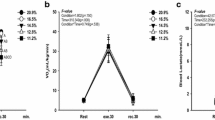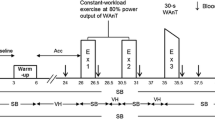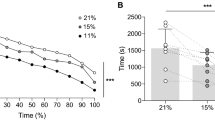Summary
The effect of severe acute hypoxia (fractional concentration of inspired oxygen equalled 0.104) was studied in nine male subjects performing an incremental exercise test. For power outputs over 125 W, all the subjects in a state of hypoxia showed a decrease in oxygen consumption (\(\dot V\)O2) relative to exercise intensity compared with normoxia (P < 0.05). This would suggest an increased anaerobic metabolism as an energy source during hypoxic exercise. During submaximal exercise, for a given \(\dot V\)O2, higher blood lactate concentrations were found in hypoxia than in normoxia (P < 0.05). In consequence, the onset of blood lactate accumulation (OBLA) was shifted to a lower \(\dot V\)O2 (\(\dot V\)O2 1.77 l·min−1 in hypoxia vs 3.10 l·min−1 in normoxia). Lactate concentration increases relative to minute ventilation (\(\dot V\) E) responses were significantly higher during hypoxia than in normoxia (P < 0.05). At OBLA, \(\dot V\) E during hypoxia was 25% lower than in the normoxic test. This study would suggest that in hypoxia subjects are able to use an increased anaerobic metabolism to maintain exercise performance.
Similar content being viewed by others
References
Adams RP, Welch HG (1980) Oxygen uptake, acid-base status, and performance with varied inspired oxygen fractions. J Appl Physiol 49:863–868
Banister EW, Woo W (1978) Effects of simulated altitude training on aerobic and anaerobic power. Eur J Appl Physiol 38:55–69
Brooks GA (1985) Anaerobic threshold: review of the concept and directions for future research. Med Sci Sports Exerc 17:22–31
Brooks GA, Butterfield GE, Wolfe RR, Groves BM, Mazzeo RS, Sutton JR, Wolfel EE, Reeves JT (1991) Decreased reliance on lactate during exercise after acclimatization to 4300 m. J Appl Physiol 71:333–341
Casaburi R, Barstow TJ, Robinson T, Wasserman K (1989) Influence of work rate on ventilatory and gas exchange kinetics. J Appl Physiol 69:547–555
Cooper DM, Wasserman DH, Vranic M, Wasserman K (1986) Glucose turnover in response to exercise during high- and low-FIO2 breathing in man. Am J Physiol 251:E209-E214
Costill DL, Thomason H, Roberts E (1973) Fractional utilization of the aerobic capacity during distance running. Med Sci Sports 5:248–252
Davis JA, Frank MH, Whipp BJ, Wasserman K (1979) Anaerobic threshold alterations caused by endurance training in middle-aged men. J Appl Physiol 46:1039–1046
Dill DB, Adams WC (1971) Maximal oxygen uptake at sea level and at 3090-m altitude in high school champion runners. J Appl Physiol 30:854–859
Eisele JH, Wuyam G, Savourey J, Eterradosi JH, Bittel JH, Benchetrit G (1992) Individuality of breathing patterns during hypoxia and exercise. J Appl Physiol 72:2446–2453
Farrell PA, Wilmore JH, Coyle EF, Billing J, Costill DL (1979) Plasma lactate accumulation and distance running performance. Med Sci Sports 11:338–344
Hogan MC, Cox RH, Welch HG (1983) Lactate accumulation during incremental exercise with varied inspired oxygen fractions. J Appl Physiol Respir Environ Exerc Physiol 55:1134–1140
Hughson RL, Xing HC, Butler GC, Northey DR (1990) Effect of hypoxia on oxygen uptake kinetics during pseudorandom binary sequence exercise. Aviat Space Environ Med 61:236–239
Jones NL, Robertson DG, Kane JW, Hart RA (1972) Effect of hypoxia on free fatty acid metabolism during exercise. J Appl Physiol 33:733–738
Jones NL, Sutton JR, Taylor R, Toews CL (1977) Effect of pH on cardiorespiratory and metabolic response to exercise. J Appl Physiol 43:959–964
Knuttgen HG, Saltin B (1973) Oxygen uptake, muscle high-energy phosphates, and lactate in exercise under acute hypoxic conditions in man. Acta Physiol Scand 87:368–376
Koike A, Wasserman K, McKenzie D, Zanconato S, Weiler-Ravel D (1990a) Evidence that diffusion limitation determines oxygen uptake kinetics during exercise in humans. J Clin Invest 86:1698–1706
Koike A, Weiler-Ravell D, McKenzie D, Zanconato S, Wasserman K (1990b) Evidence at the metabolic acidosis threshold is the anaerobic threshold. J Appl Physiol 68:2521–2526
Lawler J, Powers SK, Thompson D (1988) Linear relationship between \(\dot V\)O2max and \(\dot V\)O2max decrement during exposure to acute hypoxia. J Appl Physiol 64:1486–1492
Linnarson D (1974) Dynamics of pulmonary gas exchange and heart rate changes at start and end of exercise. Acta Physiol Scand [Suppl] 415:1–68
Linnarsson D, Karlsson J, Fagraeus L, Saltin B (1974) Muscle metabolites and oxygen deficit with exercise in hypoxia and hyperoxia. J Appl Physiol 36:399–402
Maher JT, Jones LG, Hartley LH (1974) Effects of high-altitude exposure on submaximal endurance capacity of men. J Appl Physiol 37:895–898
McLellan, Jacobs I, Lewis W (1988) Acute altitude exposure and altered acid-base states. I. Effects on the exercise ventilation and blood lactate responses. Eur J Appl Physiol 57:435–444
Mitchell JH, Sproule BJ, Chapman CB (1958) The physiological meaning of the maximal oxygen intake test. J Clin Invest 37:538–547
Murphy PC, Cuervo LA, Hughson RL (1989) A study of cardiorespiratory dynamics with step ramp exercise test in normoxia and hypoxia. Cardiovasc Res 23:825–832
Powers SK, Williams J (1987) Exercise-induced hypoxemia in highly trained athletes. Sports Med 4:46–53
Pugh LG, Gill MB, Lahiri S, Milledge JS, Ward MP, West JB (1964) Muscular exercise at great altitude. J Appl Physiol 19:431–440
Rowell LB, Saltin B, Kiens B, Christensen NJ (1986) Is peak quadriceps blood flow in humans even higher during exercise with hypoxemia? Am J Physiol 251:141038–141044
Scholander PF (1947) Analyzer for accurate estimation of respiratory gases in one-half cubic centimetre samples. J Biol Chem 167:235–250
Sjödin B, Jacobs I (1981) Onset of blood lactate accumulation and marathon running performance. Int J Sports Med 2:23–26
Springer C, Barstow TJ, Wasserman K, Cooper DM (1991) Oxygen uptake and heart rate responses during hypoxic exercise in children and adults. Med Sci Sports Exerc 23:71–79
Squires RW, Buskirk ER (1982) Aerobic capacity during acute exposure to simulated altitude, 914 to 2286 m. Med Sci Sport Exerc 14:36–40
Stanley WC, Gertz EW, Wisneski JA, Neese RA, Morris DL, Brooks GA (1986) Lactate extraction during net lactate release in legs of humans during exercise. J Appl Physiol 60:1116–1120
Sutton JR, Jones NL, Toews CJ (1981) Effect of pH on muscle glycolysis during exercise. Clin Sci 61:331–338
Sutton JR, Reeves JT, Wagner PD, Groves BM, Cymerman A, Malkonian MK, Rock PB, Young PM, Walter SD, Houston CS (1988) Operation Everest II: oxygen transport during exercise at extreme simulated altitude. J Appl Physiol 64:1309–1321
Takano N (1968) Role of hypocapnia in the blood lactate accumulation during acute hypoxia. Respir Physiol 4:32–41
Taylor HL, Buskirk E, Henschel A (1955) Maximum oxygen uptake as an objective measurement of cardiorespiratory performance. J Appl Physiol 8:73–80
Wagner JA, Miles DS, Horvath SM (1980) Physiological adjustments of woman to prolonged work during acute hypoxia. J Appl Physiol Respir Environ Exerc Physiol 49:367–373
Wagner PD (1988) An integrated view of the determinants of maximum oxygen uptake. Adv Exp Med Biol 227:245–256
Wagner PD, Gale GE, Moon RE, Torre-Bueno JR, Stolp BW, Salzman HA (1986) Pulmonary gas exchange in humans exercising at sea level and simulated altitude. J Appl Physiol 61:260–270
Wasserman K (1984) The anaerobic threshold measurement to evaluate exercise performance. Am Rev Respir Dis 129 [Suppl]:S35-S40
Wasserman K, Whipp BJ, Koyal SN, Beaver WL (1973) Anaerobic threshold and respiratory gas exchange during exercise. J Appl Physiol 35:236–243
West JB, Boyer SJ, Graber DJ, Hackett PH, Maret KH, Milledge JS, Peters RM, Pizzo CJ, Samaja M, Sarnquist FH, Schoene RB, Winslow RM (1983) Maximal exercise at extreme altitude on Mount Everest. J Appl Physiol Respir Environ Exerc Physiol 55:688–698
Xing HC, Cochrane JE, Yamamoto Y, Hughson RL (1991) Frequency domain analysis of ventilation and gas exchange kinetics in hypoxic exercise. J Appl Physiol 71:2394–2401
Yoshida T, Chida M, Ichioka M, Suda Y (1987) Blood lactate parameters related to aerobic capacity and endurance performance. Eur J Appl Physiol 56:7–11
Yoshida T, Udo M, Chida K, Makiguchi K, Ichioka M, Muraoka I (1989) Arterial blood gases, acid-base balance, and lactate and gas exchange variables during hypoxic exercise. Int J Sports Med 10:279–285
Zborowska-Sluis DT, Dossetor JB (1967) Hyperlactemia of hyperventilation. J Appl Physiol 22:746–755
Author information
Authors and Affiliations
Rights and permissions
About this article
Cite this article
Ibañez, J., Rama, R., Riera, M. et al. Severe hypoxia decreases oxygen uptake relative to intensity during submaximal graded exercise. Europ. J. Appl. Physiol. 67, 7–13 (1993). https://doi.org/10.1007/BF00377696
Accepted:
Issue Date:
DOI: https://doi.org/10.1007/BF00377696




